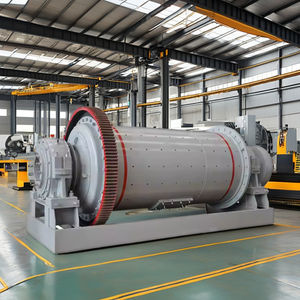PRODUCT PARAMETERS
Description
Introduction to towed excavator Rubber Track Pad
A towed excavator, also known as a tracked or tire mobile excavator, is a type of heavy equipment that is widely used in the construction and mining sectors.excavator Rubber Track Pad refers to a variety of parts that are used to maintain, repair, or replace worn-out parts of this machine.
Features and advantages of towed excavator Rubber Track Pad
Durability: made of high-quality materials to ensure long life and high durability.
Compatibility: Designed to meet OEM specifications for a wide range of makes and models.
Economical: Third-party spare parts are usually less expensive compared to OEM parts.
Ease of Replacement: Standardised design allows for quick and easy installation and replacement.
Reliability: rigorously tested to ensure stable and reliable performance.

(excavator Rubber Track Pad)
Specification of excavator Rubber Track Pad
The excavator rubber track pad is a key part for heavy machinery. It connects the track chain to the ground. The design ensures stability and reduces machine sinking on soft surfaces. The material is high-grade rubber mixed with steel or fiber cords. This mix boosts strength and resists wear. The rubber stays flexible in extreme temperatures. It works in conditions from -40°C to 50°C. The surface has deep tread patterns. These improve grip on mud, gravel, or uneven terrain. Slipping risks drop during operation.
Standard track pad widths range from 200mm to 800mm. Custom sizes fit specific excavator models. Each pad includes bolt holes for secure attachment. The hole layout matches common track chain brands. Installation requires basic tools. No welding or cutting is needed. Replacement takes minimal downtime.
Load capacity varies by pad thickness. Thicker pads handle heavier loads. A 40mm pad supports up to 35 tons. Thinner pads suit lighter machines. The rubber absorbs shocks from rough surfaces. Machine parts like rollers and sprockets face less stress. Maintenance costs lower over time.
Durability comes from anti-abrasion additives in the rubber. Rocks, debris, and sharp objects cause less damage. The material resists oil, grease, and chemicals. Performance stays steady on construction sites or mines. UV protection prevents cracking in sunlight. Long-term storage does not weaken the pads.
Track pads reduce ground pressure. Weight spreads evenly across the track area. Grass, asphalt, or concrete surfaces face less harm. Operators switch between work sites without surface prep. Noise levels stay lower compared to steel tracks. Nearby workers face less disruption.
Compatibility covers brands like Caterpillar, Komatsu, Hitachi, and others. Matching the pad to the excavator model ensures fit. Incorrect sizes risk track misalignment. Product codes or machine specs guide proper selection. Testing confirms performance under load before full use.
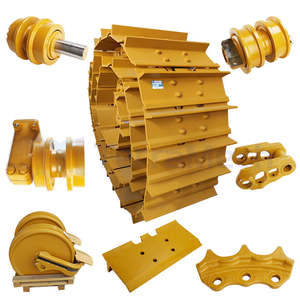
(excavator Rubber Track Pad)
Applications of excavator Rubber Track Pad
Excavator rubber track pads play a key role in heavy machinery operations. These components attach to the tracks of excavators. They provide better grip and stability on uneven or slippery surfaces. Construction sites rely on them to protect both the machine and the ground. Hard surfaces like concrete or asphalt can get damaged by metal tracks. Rubber pads reduce this risk. They also prevent excessive noise during operation. This makes them ideal for urban construction zones.
Agriculture benefits from rubber track pads. Heavy machinery often works on soft soil. Metal tracks can sink into the ground or harm crops. Rubber pads spread the machine’s weight more evenly. This minimizes soil compaction. Healthier soil leads to better crop growth. Farmers avoid damaging fields during planting or harvesting.
Mining operations use rubber track pads in harsh environments. Rough terrain and sharp rocks wear down standard tracks. Rubber pads add a layer of protection. They absorb shocks from uneven surfaces. This reduces stress on the excavator’s undercarriage. Longer equipment life means lower maintenance costs. Workers also experience less vibration. This improves comfort during long shifts.
Landscaping projects require careful ground protection. Delicate surfaces like lawns or pavements can get torn up by metal tracks. Rubber pads prevent this. They leave minimal marks on grass or decorative surfaces. Their flexibility allows smooth movement around tight spaces. Operators work efficiently without worrying about collateral damage.
Demolition sites often have debris like broken concrete or metal. Rubber track pads resist punctures and cuts. They handle sharp materials better than standard tracks. This keeps the excavator moving without frequent stops for repairs.
Cold climates pose challenges for machinery. Rubber stays flexible in low temperatures. Track pads maintain traction on icy or frozen ground. This prevents slippage and accidents. Operators work safely year-round.
Regular inspection ensures track pads perform well. Dirt or debris stuck in the tracks reduces effectiveness. Cleaning them extends their lifespan. Worn-out pads get replaced quickly. This avoids further damage to the excavator. Proper maintenance keeps projects on schedule.
Company Introduction
Established in 2007, Excavator Attachments Heavy Machinery Co.,ltd. focus on metal research and mining machinery spare parts. 2 factories over an area of 13,300 square meters, based on 100+ sets of equipment, our production capacity reaches 12000 Tons/Year. has passed ISO 9001 quality managment system certification in 2008.
Our mainly products are dragline excavator spare parts,rotary kiln spare parts, large modulus gear (gear shaft), gearbox ect. 40+ patents with over 45 years experience to help focus on improve the service life of spare parts. We belive that more than 80% reason of mechanical parts’ working life depends on hot processing (steel making/forging/casting/welding/heat treatment). Eight material engineers will control the quality from the original resource.
If you are interested, please feel free to contact us.
Payment
L/C, T/T, Western Union, Paypal, Credit Card etc.
Shipment
By sea, by air, by express, as customers request.
5 FAQs of excavator Rubber Track Pad
Rubber track pads attach to excavator tracks. They spread the machine’s weight evenly. This reduces ground pressure. Soft or uneven terrain needs this feature. Track pads protect surfaces like asphalt or concrete from damage. They improve stability during operation. Operators use them in roadwork or landscaping projects.
Rubber track pads last 1,000 to 2,000 hours. Terrain type affects lifespan. Rough surfaces like rocks wear pads faster. Regular maintenance extends durability. Check for cracks or tears weekly. Clean debris stuck between pads. Replace damaged pads quickly to avoid further issues.
Clean pads with water after muddy jobs. Remove rocks or dirt stuck in grooves. Inspect bolts and fasteners monthly. Tighten loose parts immediately. Store excavators on flat, dry surfaces when not in use. Avoid long-term exposure to sunlight. Sunlight weakens rubber over time.
Measure the excavator’s existing track width. Match pad size to the machine model. Incorrect sizes cause uneven wear. Check manufacturer guidelines for compatibility. Heavy-duty jobs need thicker pads. Lighter tasks work with standard thickness. Consult suppliers for terrain-specific recommendations.
Rubber pads cause less noise than steel. They reduce vibrations during operation. This makes them ideal for urban areas. Rubber grips surfaces better. It prevents slipping on wet ground. Steel tracks dig into asphalt or lawns. Rubber avoids this damage. Fuel efficiency improves with lighter rubber pads.
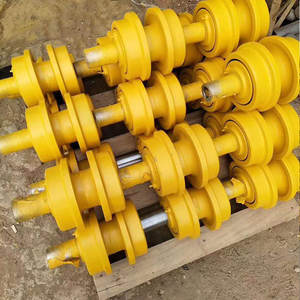
(excavator Rubber Track Pad)
REQUEST A QUOTE
RELATED PRODUCTS
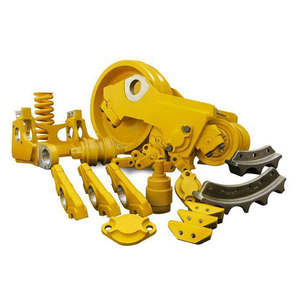
OEM High Quality Of excavator Rubber Track Pad

Track Roller Lower Rollers Bottom Roller for Excavator Undercarriage Parts SK20 SK30
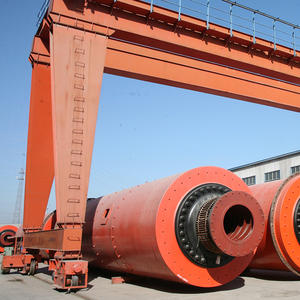
Dragline Excavator Parts long large diameter gear shaft drive Big gear shaft
